Key Takeaways:
There are several reasons as to why travel apps fail including lack of personalization, not using emerging technologies, and lack of feedback & more.
GoZoom, TripNest, JetVault, Desti, & HotelsAroundYou are some examples of travel apps that failed due to common yet avoidable mistakes.
To build a travel app that succeeds in the market, you need to start by identifying and targeting a niche audience, leveraging AI, adopting a future-ready tech stack, and ensuring seamless cross-platform functionality.
JPLoft is a leading development company for creating travel apps that not only launch but scale successfully in the market.
Now is the right time to secure a safe spot by following best practices to build an intuitive, scalable, and user-loved travel app that truly stands out.
Let's be real, exploring the world has officially gone digital. Travel isn't planned at a desk anymore; it's curated from your couch, between sips of coffee and swipes on your calendar.
You might ignore a game or skip a news app, but a travel app that gets you the best deals, live updates, and personalized trips? That's a keeper.
Why? Because modern travellers want everything: speed, flexibility, real-time information, and hassle-free experiences. The opportunity and challenge are precisely there.
This is your chance to realize your lifelong dream of creating something that aids in the exploration of new places, the discovery of hidden gems, and the optimization of travel.
We'll discuss why travel apps fail and, more importantly, how to ensure yours doesn't.
From challenges to real case studies and pro tips, this is your no-fluff, all-action guide.
Let's build something that flies.
Inside the Online Travel App Industry
The most significant online travel app problems often begin long before launch, right in the planning and early development stages.
At first glance, building a travel app may seem simple. But once you start working in this industry, you realize that it's not easy.
Travel apps work in a hyper-competitive and ever-evolving environment.
While many traditional apps rely on real-time data, third-party integrations, and seamless sharing between services, travel platforms also depend on these elements.
Every travel app feature has to work together, including booking systems, geolocation, tie-ins with local vendors, and changing pricing for flights and hotels.
Miss one beat and the whole flow falters.
Travel app startups face a high level of complexity that's easy to underestimate. And that's where the downfall begins.
Many teams become consumed by aesthetics or speed-to-market, while overlooking deeper issues such as backend scalability, API stability, or personalization engines.
Travel app business failure rarely comes from one big blunder. Instead, it's usually the result of many small, overlooked essentials, tiny cracks that eventually cause the foundation to split.
Understanding and addressing these early on is what separates successful apps from the long list of failed travel apps that never quite took off.
Top Reasons Why Online Travel Apps Fail
Even with the growing demand for travel solutions, many apps fall short. A confusing interface or lack of personalization can quickly turn users away.
Let’s explore the top reasons why travel apps fail and how to steer clear of them!
1. Robust AI Integration
AI isn't just a fancy feature; it's a game-changer for travel apps aiming to succeed in today's cutthroat market.
Skipping AI-powered capabilities, such as predictive pricing, itinerary recommendations, and dynamic suggestions, is one of the most common mistakes in travel apps.
Without AI, your platform can't deliver the innovative, personalized experiences travelers now expect, leading to travel app user experience issues and declining retention.
To truly avoid travel app failure, businesses are turning to professional AI development services.
These services help build intelligent systems that learn from user behaviour, offer tailored recommendations, and solve real-time problems in online travel apps.
Whether it's flagging price drops, curating last-minute trip ideas, or predicting booking preferences, AI keeps your app relevant and reactive.
Ignoring AI is one reason why travel app startups fail. Without it, you're just another static booking tool in a saturated space.
With it, you're a digital travel companion that users trust and rely on.
In a landscape full of failed travel apps, robust AI integration isn't optional; it's essential.
So if you're serious about bypassing issues and preventing travel app business failure, start smart. Start with AI.
2. Real-Time Updates
Travel doesn't wait, and neither should your app.
In a world where plans can change in minutes, users expect instant updates on flights, hotel bookings, itinerary changes, and even last-minute cancellations.
If your app can't keep up, it's not just inconvenient, it's a direct path to travel app failure.
One of the most overlooked challenges is real-time data integration. Without it, users are left to guess, refresh, or, worse yet, turn to their competitors.
And that's precisely how travel app startups fail, by missing the moment that matters.
Delayed or outdated information leads to frustrated users, negative reviews, and a decline in retention.
Many failed travel apps share this fatal flaw. No real-time sync.
Despite all the trends in travel app development, this remains one of the most common yet critical issues faced by modern online travel platforms.
If you're wondering what causes travel apps to fail, this is a key factor to consider.
To avoid the trap, invest in strong APIs, live syncing, and a backend that supports fast, scalable updates. Because in this space, real-time isn't just lovely, it's survival.
3. User-Centric Design
Let's be real, if users can't figure out your app in under 30 seconds, you've already lost them.
Confusing navigation, cluttered screens, or poor flow are classic user experience issues in travel apps that often pave the way for failure.
Design isn't just about colours and icons; it's about guiding users with ease and simplicity. And that starts early, during wireframing and building your app prototype.
Skipping or rushing these steps is one of the most common yet overlooked mistakes in travel apps.
Many startups fall in love with their visuals and overlook functionality, which is a significant reason why travel app startups often fail. Travelers want speed, clarity, and comfort, not a puzzle.
Strong UX backed by thoughtful wireframing and a tested app prototype solves many online travel app problems before they ever go live.
It boosts retention, increases conversion, and reduces bounce rates —three essential ingredients for avoiding travel app business failure.
So, if you're wondering what causes travel apps to fail, start with the user journey. Because when users enjoy the ride, they stick around for the destination.
4. Offline Access
In the world of travel, Wi-Fi isn't always a guarantee, and your app needs to be ready for that.
A lack of offline functionality is one of the most underestimated causes of travel app user retention issues and, ultimately, travel app failure.
Think about it: a user lands in a remote area, opens your app, and finds nothing. No itinerary.
No maps. No booking info. That moment of frustration can turn into a negative review or a full-on uninstall.
What causes travel apps to fail? This is right here.
Failing to offer even basic offline features, such as saved bookings, maps, or itineraries, is a significant red flag in today's market.
It's also a sign of poor planning during travel app market research.
To avoid this common travel app mistake, developers should incorporate offline access into the app prototype and prioritize it during the wireframing process.
Doing so boosts trust, enhances usability, and helps your platform avoid joining the long list of failed travel apps.
To win the retention game and avoid travel app business failure, ensure your app functions even when the signal is weak.
5. Secure and Simple Payment Systems
Nothing kills a booking faster than a clunky checkout.
Slow payment gateways, failed transactions, or confusing payment flows are among the most frequent issues with online travel apps, leading directly to user abandonment and ultimately, travel app failure.
In the travel space, users expect speed, simplicity, and above all, security.
If your app lacks robust mobile app security, users will be hesitant to trust it with their credit card details, especially when booking high-ticket flights or hotels.
And that trust, once lost, is nearly impossible to regain.
This is one of the top common travel app mistakes, underestimating the importance of seamless and secure transactions.
It's also a significant reason why travel app startups fail.
Payment friction not only hurts conversions but also triggers negative reviews and drop-offs, adding to travel app user retention issues.
To avoid this issue, ensure your app prototype includes secure gateways, PCI-compliant systems, and support for wallets, cards, and UPI payments.
Testing this rigorously during wireframing and development is key.
Ultimately, avoiding travel app business failure begins with giving users peace of mind. If your checkout feels risky, they'll check out for good.
6. Comprehensive Booking Features
Let's be honest, no one wants to jump between five different apps to plan a trip.
If your travel app doesn't offer comprehensive booking features, users will bounce faster than a last-minute flight cancellation.
And yes, that frustration leads directly to travel app business failure.
Apps that lack integrated options for booking flights, hotels, rental cars, travel insurance, and local experiences often create fragmented journeys.
That disjointed experience is one of the biggest challenges in travel apps and a major contributor to travel app user retention issues & becomes a reason why online travel apps fail.
Users want a one-stop shop, an app that simplifies travel, not complicates it.
Offering a full suite of services under one roof eliminates the need to juggle tabs, builds trust, and keeps users engaged.
To avoid being lumped in with failed travel apps, incorporate these capabilities into your app prototype early, during the wireframing stage.
The more complete the booking journey, the higher the chances your app succeeds.
7. Strong Vendor Partnerships
In the travel app ecosystem, your app is only as strong as the vendors it connects with.
From airlines and hotels to car rentals and local tour operators, strong API partnerships are the backbone of a reliable experience.
Weak or inconsistent vendor integrations lead to delayed bookings, incorrect availability, and broken trust, which are among the top reasons why travel app startups fail.
Many challenges stem from poor communication with vendors or unreliable third-party APIs.
When users encounter errors, outdated info, or mismatched listings, it directly contributes to travel app user experience issues and negative reviews.
To avoid travel app business failure, invest in building solid, scalable partnerships from the start.
Test APIs thoroughly during your app prototype phase and ensure they're robust enough to scale with your platform.
Because at the end of the day, a travel app that can't deliver real-time, reliable data from trusted vendors is headed straight toward the "failed travel apps" list.
8. Machine Learning (ML) for Personalization
If your travel app isn't personal, it's forgettable. Generic recommendations and cookie-cutter itineraries are no longer sufficient.
This is where Machine Learning (ML) becomes your secret weapon.
ML helps apps learn from user behaviour, browsing patterns, past bookings, preferences, and deliver ultra-relevant suggestions in real time.
This kind of personalization isn't just a fancy feature, it's a proven way to boost engagement and reduce travel startup failures caused by bland, one-size-fits-all experiences.
Apps that adapt to individual users tend to see higher retention and stronger conversion rates, avoiding many travel app user experience issues and common online travel app problems.
By integrating a professional ML development service, your app can surpass static filters and become an innovative, evolving platform that anticipates travellers' needs before they even search.
In a market where users demand more, ML-driven personalization can be the difference between app loyalty and app deletion. It's a key player in avoiding travel app failure and business failure altogether.
9. Effective Push Notifications
Let's be honest, no one likes getting spammed.
And in the world of travel apps, nothing drives uninstalls faster than irrelevant or excessive notifications.
This is one of the sneakiest travel app user retention issues and a subtle but deadly reason behind travel app failure.
But when done right? Push notifications become powerful tools.
Thoughtful, timely, and personalized nudges, like flight updates, price drops, booking reminders, or trip suggestions, can boost engagement and reduce travel startup failures.
The key lies in context. Blanket messages don't work.
Travelers want info that's relevant to their journey, and sending the right message at the right time is what separates the winners from the failed travel apps.
To avoid this common travel app mistake, plan your notification strategy early during the wireframing and app prototype phase.
When aligned with user behaviour and powered by AI in travel app features or ML-driven insights, push notifications do more than alert users.
They become smart, personalized nudges that drive user retention, increase loyalty, and help prevent travel app business failure.
10. Scalable Architecture
Success can be a double-edged sword, especially if your app isn't built to handle it.
Many travel app startups fail not from a lack of users, but from poorly planned architecture that collapses under pressure.
Sudden growth can lead to server overloads, app crashes, and laggy performance, all of which contribute to travel app user experience issues and ultimately result in the failure of the travel app.
One of the most overlooked challenges in travel app development is building a backend that's ready for scale.
Whether it's handling real-time booking spikes, simultaneous user logins, or live updates, your app needs a strong, flexible foundation.
Skipping scalability planning during the app prototype or wireframing phase is a common mistake to avoid.
By the time issues show up, it's often too late, and you're on the fast track to the growing list of failed travel apps.
To avoid travel app business failure, build for the future, not just launch day.
11. Not Using Natural Language Processing (NLP)
Let's face it, no one wants to tap through endless menus when they could ask. That's where Natural Language Processing (NLP) comes into play.
From voice search to chat-based support and conversational bookings, NLP brings ease, speed, and a whole lot of satisfaction to your app's user experience.
The lack of conversational interfaces is one of the most overlooked challenges and a sneaky reason why travel app startups fail.
With innovative NLP development services, your app can interpret user queries naturally, respond in real time, and guide users effortlessly, minimizing friction and reducing travel app user experience issues.
Want to stand out from the crowd of failed travel apps?
Then make your app talk, literally. Integrating NLP during your app prototype and wireframing phases helps avoid many online travel app problems from the start.
In today's world, users don't just want convenience; they want conversation. And that is how you dodge travel app business failure.
12. Continuous Feedback Loops
Let's discuss something that many travel app startups overlook: user feedback.
Those app reviews, bug reports, and little suggestions users drop? Ignoring them is one of the most classic (and fatal) travel app mistakes to avoid.
Apps that succeed aren't built once, they're built over and over, with every update shaped by what real users want. This is where continuous feedback loops come in.
They help you catch blind spots early, fix travel app user experience issues, and keep your platform aligned with evolving traveler needs.
Start building feedback into your app prototype phase. Use in-app surveys, reviews, and behavior tracking to guide your iterations.
Because honestly, guessing is risky, and one wrong move can land you on the "failed travel apps" list.
If you're serious about avoiding travel app business failure and creating something users love, don't just build it and forget it.
Listen. Learn. Improve. That's how winning apps are made, one genuine opinion at a time.
Lessons from Failure: Case Studies of Travel Apps That Didn't Make It
Real-world travel startup failures are more valuable than any theory-packed playbook.
These stories are brutal, honest, and full of the exact insights founders wish they'd had before launch.
So, if you're serious about avoiding travel app failure, let's dive into these cautionary tales of once-promising platforms that missed the mark.
► GoZoom
A sleek interface and solid funding made GoZoom a hot topic. But underneath the sight?
A mess. It suffered from poor integration, lag, and downtime, classic travel app performance issues.
Users were unable to complete bookings, resulting in negative reviews and a high rate of uninstalls. A textbook example of what causes travel apps to fail.
► TripNest
TripNest was all style, no substance. The UI looked terrific, but with no real-time updates, offline access, or smooth navigation, users were quickly turned off.
They forgot that design without usability equals disaster. The result? A major travel app user experience issue, resulting in a hard fall into the failed travel apps category.
► Roamerly
Designed for digital nomads (cool idea, right?), Roamerly lacked basic filtering options, and custom trip plans, and had no proper monetization strategy.
It's a classic case of mobile app failure in the travel industry, a great niche, poorly executed.
► JetVault
The tech behind JetVault was outdated from day one. As user traffic increased, the app was unable to scale, resulting in a crashing experience.
This is one of the huge challenges that gets ignored during MVP builds.
When your app can't grow with your audience, you're headed for a failed travel app business.
► Desti
Marketed as an AI-powered travel planner, Desti was all talk. The so-called AI was smoke and mirrors, just canned suggestions.
Users caught on, engagement dropped, and the platform suffered a decline. This is a shining example of why travel app startups fail, overpromise, and severely underdeliver.
► HotelsAroundYou
It succeeded locally, but when it attempted to scale globally, things fell apart. Why? Weak vendor APIs, no localization, and a total lack of scalability.
It's a painful case of missed opportunity, driven by poor planning and a lack of long-term infrastructure, a one-way ticket to travel app failure.
► Stayzilla
One of the most well-known names in the Indian travel space, Stayzilla had all the pieces, except harmony.
It struggled to balance supply and demand, failed to handle regulation, and encountered trust issues with vendors.
A complex and heavy-hitting travel app startup failure that proves tech alone isn't enough, you need business sense, too.
Each of these real-life flops is a loud, flashing warning sign.
They reveal exactly what causes travel apps to fail, from clunky tech and UX issues to lack of scalability, false promises, and misaligned market fit.
If you're not solving these challenges early, you're not building a product, you're building a lesson.
How to Build a Travel App That Works?
So now that we've unpacked the reasons behind all those painful travel app failures, it's time to flip the script.
Here's how to build a travel app that not only survives but thrives in a competitive, ever-evolving market.
Step 1: Identify and Target a Niche Audience
Here's the truth, if you're trying to build a "one-size-fits-all" travel app, you're probably setting yourself up for failure.
Instead, zoom in. Backpackers, luxury jet-setters, digital nomads, weekend wanderers, pick one.
Avoiding travel app failure begins with identifying a specific audience and designing features that cater directly to their travel behavior.
Step 2: Design an Effortless User Experience (UX)
UI/UX should be so seamless that users barely notice, seamlessly flowing from search to booking.
That's why app wireframing and building a clickable app prototype are non-negotiables.
A smooth UX reduces travel app user experience issues and helps eliminate online travel app problems from the very beginning.
Step 3: Leverage AI for Smart Personalization
Want to know why some travel apps fail while others succeed? One word: personalization.
Use generative AI development services to analyze user behavior, serve hyper-relevant results, and send contextual push notifications.
This creates an app that feels like a personal travel assistant, not a generic booking tool.
Step 4: Adopt a Future-Ready Tech Stack
Here's where many apps fumble. Outdated architecture, clunky APIs, and sync delays pose numerous challenges.
Go for modular APIs, real-time syncing, and serverless architecture from the start. Future-proof your build to avoid patching holes later.
Step 5: Go Cross-Platform from Day One
You can't afford to play favourites. Your users are on Android, iOS, and the Web, and your app needs to be, too.
Inconsistent platform delivery is one of the silent killers behind why most travel apps don't succeed.
Investing wisely in the cost to develop a travel app means prioritizing cross-platform compatibility to ensure maximum reach and stability.
Step 6: Craft a Smart Monetization Strategy
If ads are your only revenue stream, rethink that. Utilize mobile app monetization strategies such as premium plans, affiliate partnerships, and smart subscriptions.
These aren't just ways to make money, they're tools to avoid travel app business failure and scale.
Step 7: Prioritize Speed, Stability & Security
Even the best-looking apps get deleted if they lag. Fast load times, zero crashes, and strong app security are not luxuries, they are expectations.
Skimp on performance or neglect mobile app maintenance, and you are on the fast track to travel app startup failure.
Step 8: Enable Key Offline Capabilities
Poor internet shouldn't break your app. Allow users to view saved bookings, maps, or itineraries offline.
This small move addresses significant travel app user retention issues, providing your users with peace of mind wherever they go.
Why JPLoft Is the Right Tech Partner to Build Your Travel App Idea?
Looking for a trusted travel app development company to bring your vision to life?
JPLoft is your perfect match. With over 10 years of experience and more than 1,100 successful projects, we understand the mistakes while developing travel apps
that cause others to fail.
Our expert team builds feature-rich apps with AI-powered personalization, real-time updates, secure payments, and offline capabilities, all of which are vital to avoiding travel app failure.
We also utilise cutting-edge technologies, such as AR/VR and AI chatbots, to deliver immersive experiences and 24/7 support.
Partner with JPLoft for a scalable, user-friendly travel app that boosts engagement, drives revenue and stands out in a competitive market.
Your success is our mission. Let's create something unforgettable together.
Wrapping Up
Why online travel apps fail is no longer a mystery.
The reasons typically involve a combination of overlooking user needs, making poor technology choices, and missing key monetization opportunities.
From common issues to critical UX flaws and stories of travel app business failure, the warning signs are clear and widespread.
Avoiding these pitfalls requires a strategic approach that aligns product design, market demand, and flawless execution.
Successful travel apps are built with a deep understanding of their audience and a clear intention to solve real problems.
To develop a travel app that stands the test of time and avoids the fate of many failed travel apps, start with thorough research, invest in the right technology, and create an engaging, user-friendly experience.
Planning is the key to long-term success.
FAQs
Travel apps often fail due to poor user experience (UX), lack of real-time updates, ineffective AI integration, and missing offline access features. Additionally, weak vendor partnerships and inadequate payment systems can also lead to app failure.
AI can enhance user experience by offering personalized recommendations, dynamic pricing, and real-time travel updates. Implementing AI-powered features ensures the app stays relevant and adapts to user preferences, increasing engagement and retention.
Real-time data integration is essential for providing instant updates on flight schedules, hotel availability, and itinerary changes. Without it, users face frustration, leading to poor reviews and uninstalls, which can result in app failure.
To ensure seamless UX, prioritize simple navigation, quick load times, and clear interfaces. A well-tested app prototype and strong wireframing can help address potential user experience issues early on.
A successful travel app should offer comprehensive booking options (flights, hotels, rentals), real-time updates, offline access, secure payment systems, and robust vendor integrations. Additionally, features like AI personalization and scalable architecture are key to long-term success.





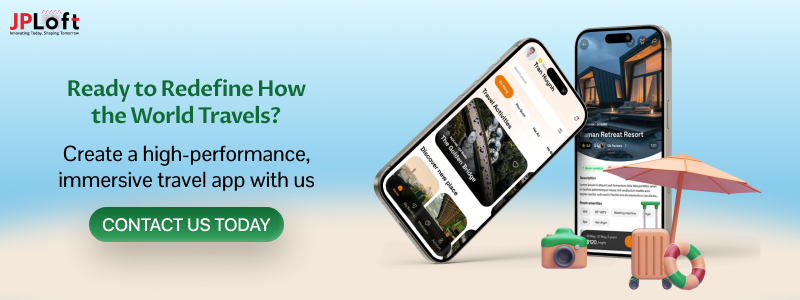
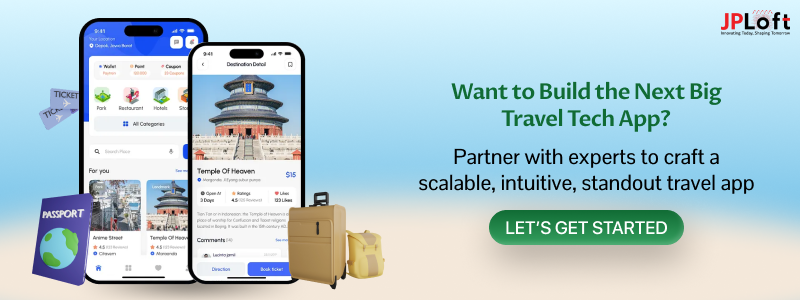
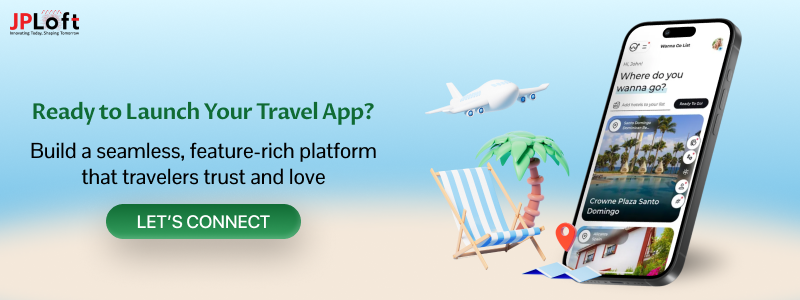

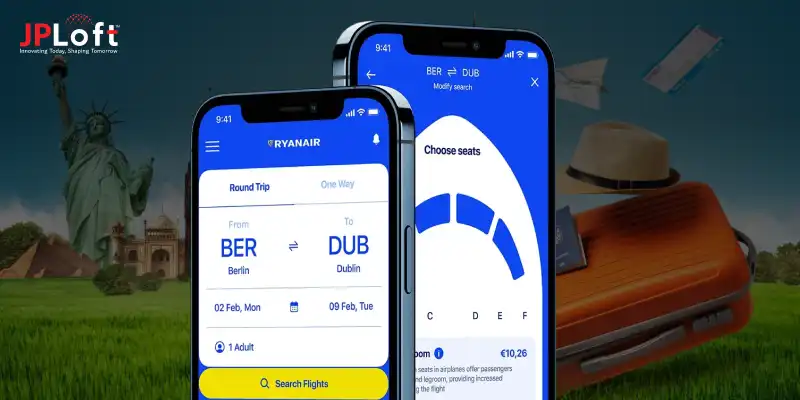
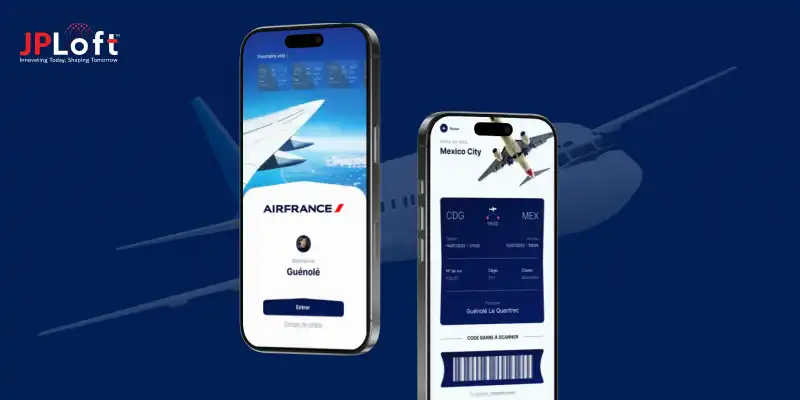
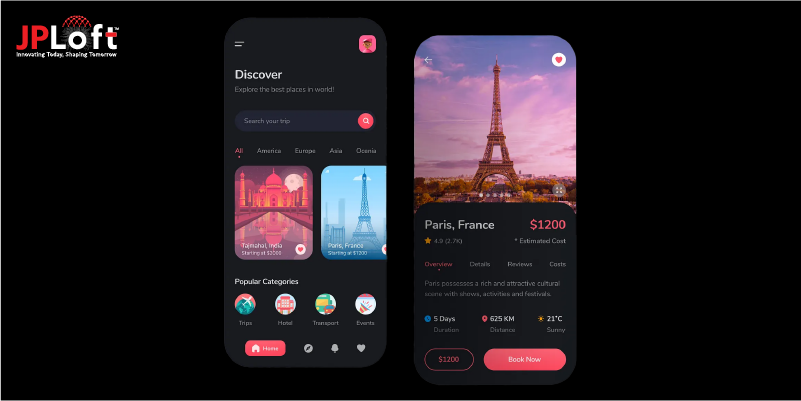


Share this blog